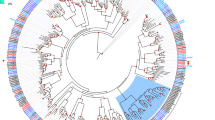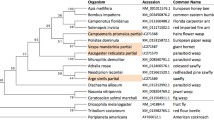Abstract
We have recently identified a tachykinin-related peptide (AmTRP) from the mushroom bodies (MBs) of the brain of the honeybee Apis mellifera L. by using direct matrix-assisted laser desorption/ionization with time-of-flight mass spectometry and have isolated its cDNA. Here, we have examined prepro-AmTRP gene expression in the honeybee brain by using in situ hybridization. The prepro-AmTRP gene is expressed predominantly in the MBs and in some neurons located in the optic and antennal lobes. cDNA microarray studies have revealed that AmTRP expression is enriched in the MBs compared with other brain regions. There is no difference in AmTRP-expressing cells among worker, queen, and drone brains, suggesting that the cell types that express the prepro-AmTRP gene do not change according to division of labor, sex, or caste. The unique expression pattern of the prepro-AmTRP gene suggests that AmTRPs function as neuromodulators in the MBs of the honeybee brain.









Similar content being viewed by others
References
Balling A, Technau GM, Heisenberg M (1987) Are the structural changes in adult Drosophila mushroom bodies memory traces? Studies on biochemical learning mutants. J Neurogenet 4:65–73
Ben-Shahar Y, Robichon A, Sokolowski MB, Robinson GE (2002) Influence of gene action across different time scales on behavior. Science 296:741–744
Bono M de, Bargmann CI (1998) Natural variation in a neuropeptide Y receptor homolog modifies social behavior and food response in C. elegans. Cell 94:679–689
Davis RL (1993) Mushroom bodies and Drosophila learning. Neuron 11:1–14
Durst C, Eichmüller S, Menzel R (1994) Development and experience lead to increased volume of subcompartments of the honeybee mushroom body. Behav Neural Biol 62:259–263
Farris SM, Robinson GE, Davis RL, Fahrbach SE (1999) Larval and pupal development of the mushroom bodies in the honey bee, Apis mellifera. J Comp Neurol 414:97–113
Ferguson JN, Young LJ, Hearn EF, Matzuk MM, Insel TR, Winslow JT (2000) Social amnesia in mice lacking the oxytocin gene. Nat Genet 25:284–288
Ferguson JN, Aldag JM, Insel TR, Young LJ (2001) Oxytocin in the medial amygdala is essential for social recognition in the mouse. J Neurosci 21:8278–8285
Ghosh A, Greenberg ME (1995) Calcium signaling in neurons: molecular mechanisms and cellular consequences. Science 268:239–247
Glantz RM, Miller CS, Nässel DR (2000) Tachykinin-related peptide and GABA-mediated presynaptic inhibition of crayfish photoreceptors. J Neurosci 20:1780–1790
Heisenberg M (1998) What do the mushroom bodies do for the insect brain? Learn Mem 5:1-10
Heisenberg M, Borst A, Wagner S, Byers D (1985) Drosophila mushroom body mutants are deficient in olfactory learning. J Neurogenet 2:1–30
Ignell R (2001) Monoamines and neuropeptides in antennal lobe interneurons of the desert locust, Schistocerca gregaria: an immunocytochemical study. Cell Tissue Res 306:143–156
Insel TR, Young LJ (2000) Neuropeptides and the evolution of social behavior. Curr Opin Neurobiol 10:784–789
Johard HA, Muren JE, Nichols R, Larhammar DS, Nässel DR (2001) A putative tachykinin receptor in the cockroach brain: molecular cloning and analysis of expression by means of antisera to portions of the receptor protein. Brain Res 919:94–105
Kamikouchi A, Takeuchi H, Sawata M, Ohashi K, Natori S, Kubo T (1998) Preferential expression of the gene for a putative inositol 1, 4, 5-trisphosphate receptor homologue in the mushroom bodies of the brain of the worker honeybee Apis mellifera L. Biochem Biophys Res Commun 242:181–186
Kamikouchi A, Takeuchi H, Sawata M, Natori S, Kubo T (2000) Concentrated expression of Ca2+/calmodulin-dependent protein kinase II and protein kinase C in the mushroom bodies of the brain of the honeybee Apis mellifera L. J Comp Neurol 417:501–510
Kim MY, Lee BH, Kwon D, Kang H, Nässel DR (1998) Distribution of tachykinin-related neuropeptide in the developing central nervous system of the moth Spodoptera litura. Cell Tissue Res 294:351–365
Kovacs W, Stangl H, Völkl A, Schad A, Dariush Fahimi H, Baumgart E (2001) Localization of mRNAs encoding peroxisomal proteins in cell culture by non-radioactive in situ hybridization. Comparison of rat and human hepatoma cells and their responses to two divergent hypolipidemic drugs. Histochem Cell Biol 115:499–508
Kwok R, Nässel DR, Lange AB, Orchard I (1999) Locustatachykinin isoforms in the locust: distribution and quantification in the central nervous system and action on the oviduct muscle. Peptides 20:687–694
Liu L, Wolf R, Ernst R, Heisenberg M (1999) Context generalization in Drosophila visual learning requires the mushroom bodies. Nature 400:753–756
Lundquist CT, Nässel DR (1997) Peptidergic activation of locust dorsal unpaired median neurons: depolarization induced by locustatachykinins may be mediated by cyclic AMP. J Neurobiol 33:297–315
Lundquist CT, Clottens FL, Holman GM, Riehm JP, Bonkale W, Nässel DR (1994) Locustatachykinin immunoreactivity in the blowfly central nervous system and intestine. J Comp Neurol 341:225–240
Menzel R, Giurfa M (2001) Cognitive architecture of a mini-brain: the honeybee. Trends Cogn Sci 5:62–70
Mobbs PG (1982) The brain of the honeybee Apis mellifera. 1. The connections and spatial organization of the mushroom bodies. Philos Trans R Soc Lond Biol 298:309–354
Mobbs PG (1984) Neural networks in the mushroom bodies of the honeybee. J Insect Physiol 30:43–58
Mobbs PG (1985) Brain structure. In: Kerkut GA, Gilbert LI (ed) Comprehensive insect physiology, biochemistry and pharmacology, vol 5. Pergamon Press. Oxford, pp 300–353
Müller U (1997) Neuronal cAMP-dependent protein kinase type II is concentrated in mushroom bodies of Drosophila melanogaster and the honeybee Apis mellifera. J Neurobiol 33:33–44
Muren JE, Nässel DR (1997) Seven tachykinin-related peptides isolated from the brain of the Madeira cockroach: evidence for tissue-specific expression of isoforms. Peptides 18:7–15
Nässel DR (1993) Insect myotropic peptides: differential distribution of locustatachykinin- and leucokinin-like immunoreactive neurons in the locust brain. Cell Tissue Res 274:27–40
Nässel DR (1999) Tachykinin-related peptides in invertabrates: review. Peptides 20:141–158
Nässel DR (2002) Neuropeptides in the nervous system of Drosophila and other insects: multiple roles as neuromodulators and neurohormones. Prog Neurobiol 68:1–84
Nässel DR, Kim MY, Lundquist CT (1995) Several forms of callitachykinins are distributed in the central nervous system and intestine of the blowfly Calliphora vomitoria. J Exp Biol 198:2527–2536
Ohashi K, Natori S, Kubo T (1997) Change in the mode of gene expression of the hypopharyngeal gland cells with an age-dependent role change of the worker honeybee. Eur J Biochem 249:797–802
Ohashi K, Natori S, Kubo T (1999) Expression of amylase and glucose oxidase in the hypopharyngeal gland with an age-dependent role change of the worker honeybee (Apis mellidera L.). Eur J Biochem 265:127–133
Park J-M, Kunieda T, Takeuchi H, Kubo T (2002) DNA-binding properties of Mblk-1, a putative transcription factor from the honeybee. Biochem Biophys Res Commun 291:23–28
Park J-M, Kuieda T, Kubo T (2003) The activity of Mblk-1, a mushroom body-selective transcription factor from the honeybee, is modulated by the Ras/MAPK pathway. J Biol Chem 278:18689–18694
Robinson GE, Fahrbach SE, Winston ML (1997) Insect societies and the molecular biology of social behavior. Bioessays 19:1099–1108
Rybak J, Menzel R (1998) Integrative properties of the Pe1 neuron, a unique mushroom body output neuron. Learn Mem 5:133–145
Sawata M, Yoshino D, Takeuchi H, Kamikouchi A, Ohashi K, Kubo T (2002) Identification and punctate nuclear localization of a novel noncoding RNA, Ks-1, from the honeybee brain. RNA 8:772–785
Schafer S, Bicker G (1986) Distribution of GABA-like immunoreactivity in the brain of the honeybee. J Comp Neurol 246:287–300
Siviter RJ, Coast GM, Winther AM, Nachman RJ, Taylor CA, Shirras AD, Coates D, Isaac RE, Nässel DR (2000) Expression and functional characterization of a Drosophila neuropeptide precursor with homology to mammalian preprotachykinin A. J Biol Chem 275:23273–23280
Strausfeld NJ (2002) Organization of the honey bee mushroom body: representation of the calyx within the vertical and gamma lobes. J Comp Neurol 450:4-33
Strausfeld NJ, Homberg U, Kloppenburg P (2000) Parallel organization in honey bee mushroom bodies by peptidergic Kenyon cells. J Comp Neurol 424:179–195
Takeuchi H, Kage E, Sawata M, Kamikouchi A, Ohashi K, Ohara M, Fujiyuki T, Kunieda T, Sekimizu K, Natori S, Kubo T (2001) Identification of a novel gene, Mblk-1, that encodes a putative transcription factor expressed preferentially in the large-type Kenyon cells of the honey bee brain. Insect Mol Biol 10:487–494
Takeuchi H, Fujiyuki T, Shirai K, Matsuo Y, Kamikouchi A, Fujinawa Y, Kato A, Tsujimoto A, Kubo T (2002) Identification of genes expressed preferentially in the honeybee mushroom bodies by combination of differential display and cDNA microarray. FEBS Lett 513:230-234
Takeuchi H, Yasuda A, Yasuda-Kamatani Y, Kubo T, Nakajima T (2003) Identification of a tachykinin-related neuropeptide from the honeybee brain using direct MALDI-TOF MS and its gene expression in worker, queen and drone heads. Insect Mol Biol 12:291–298
Vitzthum H, Homberg U (1998) Immunocytochemical demonstration of locustatachykinin-related peptides in the central complex of the locust brain. J Comp Neurol 390:455–46
Wegerhoff R, Breidbach O, Lobemeier M (1996) Development of locustatachykinin immunopositive neurons in the central complex of the beetle Tenebrio molitor. J Comp Neurol 375:157–166
Withers GS, Fahrbach SE, Robinson GE (1993) Selective neuroanatomical plasticity and division of labour in the honeybee. Nature 364:238–240
Winston ML (1987) The biology of the honeybee. Harvard University Press, Cambridge
Würden S, Homberg U (1995) Immunocytochemical mapping of serotonin and neuropeptides in the accessory medulla of the locust, Schistocerca gregaria. J Comp Neurol: 305–319
Yasuda-Kamatani Y, Yasuda A (2000) Identification of orcokinin gene-related peptides in the brain of the crayfish Procambarus clarkii by the combination of MALDI-TOF and on-line capillary HPLC/Q-Tof mass spectrometries and molecular cloning. Gen Comp Endocrinol 118:161–72
Author information
Authors and Affiliations
Corresponding author
Additional information
This work was supported by a Grant-in-Aid from the Bio-oriented Technology Research Advancement Institution (BRAIN)
Rights and permissions
About this article
Cite this article
Takeuchi, H., Yasuda, A., Yasuda-Kamatani, Y. et al. Prepro-tachykinin gene expression in the brain of the honeybee Apis mellifera . Cell Tissue Res 316, 281–293 (2004). https://doi.org/10.1007/s00441-004-0865-y
Received:
Accepted:
Published:
Issue Date:
DOI: https://doi.org/10.1007/s00441-004-0865-y




